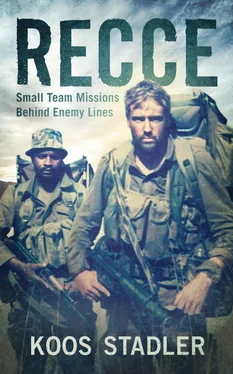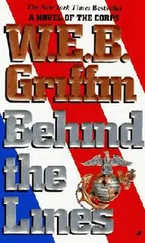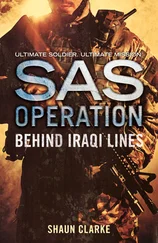To carry the explosives to the target, we designed a pack containing compartments for nine charges, each of which could be reached without having to take the pack off – except the one in the centre of the pack, which could not easily be reached by hand. This pouch we stacked with one day’s food and our E&E kit.
Water was another challenge. In order to be agile and flexible for the stalk, we preferred not to carry water bottles in kidney pouches on the sides of the body. Thus a full water bag was attached to the centre of the rucksack. The bag had the added advantage that the water would not make a noise, as it would in a half-filled bottle, while we were on the move.
Our preparations were put to the test when, during the last two weekends before our deployment to Rundu, we conducted full dress rehearsals at Hoedspruit. There we recreated the conditions we expected at the target – the distance to approach to the perimeter fence, a dark moon phase and the distance to cover on the hardstand to reach the aircraft.
The SAAF had been requested to provide us with all necessary support, and so one of the fortified hangars was left open, while four Mirages were parked outside. The base security squadron had been put on alert for the weekend. As far as they were concerned, the Recces would be doing an exercise against them and they would go all out to detect us.
The three-man team crossed the perimeter fence undetected. We lay up inside the base for a day, and then donned the sheepskin covers and infiltrated to the hardstand where the Mirages were parked. It was a pitch-dark night, and we found that we could stalk the “enemy” – our own Small Team colleagues and some counterintelligence personnel from HQ in Pretoria guarding the planes – to within a few metres before we were detected. We practised the stalk, fine-tuning the posture and adjusting the equipment until finally, in the early hours of the morning, both Diedies and I could stalk to within touching distance of the sentry.
The dress rehearsal at Hoedspruit gave rise to another ingenious invention: a harness we designed for the night-vision goggles. The normal neck strap was no good when you had to crawl or climb. The new harness consisted of a neck strap with the addition of an elastic band around the body, which would hold the goggles tight to the chest. In this way the operator could use both hands without having to worry about the night-vision goggles swinging loose. When he wanted to use the night vision he simply had to pull it away from the chest, while the elastic would tug it back into position once he let go. Also, to prevent the greenish glow from the night vision reflecting on the face, we had a piece of sheepskin moulded around each eyepiece.
I attended the final briefing in Pretoria with Diedies. Since approval for the mission had already been given, this briefing served to coordinate Air Force support, as well as contingencies in case of a capture or E&E situation. Diedies ran through the operational plan and then covered all the contingencies should anything go wrong. He listed the requirements for C-130 transport to Rundu, drop-off and pick-up by helicopter and procedures for telstar (comms relay). Close air support was not even mentioned, as the mission would be completely clandestine and non-traceable. UNITA would claim any credit, and the South African government would deny involvement in the event of the mission being compromised.
For this operation a new element was introduced to the emergency plan. Each operator drafted a personal contingency plan, dubbed “Captured Info”, that contained all the actions he would execute in case he was captured and managed to survive. The content would be memorised and the document handed to the Tac HQ commander for safekeeping before the deployment. Each operator had a secret code – unobtrusive hand signals, facial expressions or blinking the eyes in a certain way – by which he would communicate should he be captured and exposed on TV.
Every possible means of communication with own forces would be considered and described in detail, while methods of receiving messages, through a Red Cross representative, a visiting family member or a lawyer, would be included. Coded messages could, for example, be hidden in the text of a magazine that the captured operator might receive through a visitor. The Captured Info plan became part of our emergency procedures; we rehearsed it before every deployment until the content was ingrained.
A few days after arriving at Rundu, mission commander Ormonde Power called us for an intelligence update from Dave Drew. While the rehearsals were reassuring, the final intelligence brief was not. According to information gleaned from UNITA, the MiGs were allegedly guarded by FAPLA troops who slept underneath them.
Just before deployment, Colonel Terence Murphy, the senior Ops officer at Special Forces HQ, flew to Rundu from Pretoria, accompanied by Eric McNelly, the counterintelligence guy, and Oom Sarel Visser, our chaplain. Colonel Murphy asked to see the team alone. When he faced the three of us – Diedies, Neves and me – behind closed doors he said, “We cannot afford to have you compromised – either killed or captured. The boss man said I must give you the option not to deploy. If they are indeed sleeping under the aircraft there is no way you can get in without being compromised.”
“You see, Colonel,” Diedies responded, unfazed, “if we don’t go, we’ll never know. Let’s rather go see for ourselves. If they are indeed sleeping under the aircraft, we can’t do the job. If they’re not, we’ll get the job done.”
And that was that. No further argument.
Still, these must have been trying times for Diedies. He had become engaged, and his fiancée, Rietjie Wentzel, worked at the intelligence division of Special Forces HQ. Rietjie was close to the action in the sense that she was informed about all our missions. She would literally follow every step of the deployment and would know immediately when the team was in trouble.
Final kit inspection was done by Eric McNelly and Diedies. They went meticulously through every single piece of equipment, Eric checking for non-traceability and Diedies for functionality, camouflage and whether the item was properly secured to the webbing. Every torch, every night-vision device, every radio had to be switched on and tested. Magazines were emptied and reloaded; weapons were tested again.
Just before we deployed, Oom Sarel read from the Bible, gave a brief message and shared communion with the operators and the doctor.
Two Pumas transported us to a UNITA base approximately 80 km southeast of Menongue. Our old friend Mickey, now a UNITA major, flew with us and acted as our liaison. It was a well-established base, and we were allocated the “guesthouse”, complete with beds and mattresses made of cut branches and grass. We had to wait a while for our transport and for the right moon phase – between dark moon and first quarter – which would give us a slight moon in the early evening.
When our transport, a South African Kwêvoël truck, finally arrived, it took a day’s slow driving to reach the drop-off point, as UNITA was weary of FAPLA aircraft and ground patrols. At the drop-off the UNITA soldiers established a temporary base where they would wait for our return. The doctor remained with them, while Diedies, Neves and I started the approach to the target.
Even though the Menongue airfield might have been easier to penetrate than Lubango, it was an exceptionally difficult target to reach due to the open fields surrounding the town. Furthermore, the Angolan militia, a uniformed citizen force equipped with rifles, had the nasty habit of patrolling from kraal to kraal, occasionally shooting, apparently at random and at no specific target. This was quite nerve-racking to a team hidden in the undergrowth.
Читать дальше












